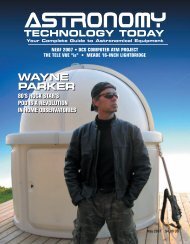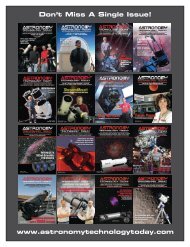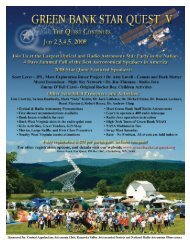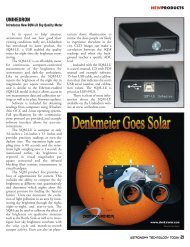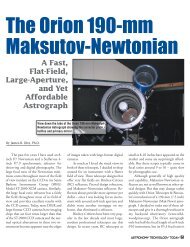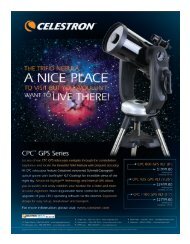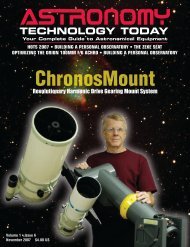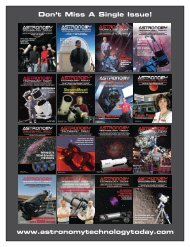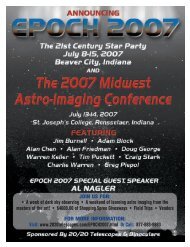iOPTRON - Astronomy Technology Today
iOPTRON - Astronomy Technology Today
iOPTRON - Astronomy Technology Today
Create successful ePaper yourself
Turn your PDF publications into a flip-book with our unique Google optimized e-Paper software.
The Rigel Systems<br />
USB nSTEP and<br />
AstroSystems<br />
Collimation Tools<br />
Two Keys to Successful Imaging<br />
with a Fast Newtonian<br />
By Austin Grant<br />
When I started looking for my first<br />
“serious” telescope for astrophotography, I<br />
knew that the decision would come down<br />
to several tradeoffs. While the precisioncrafted<br />
optical masterpieces from the likes<br />
of Astro Physics or TEC would’ve been my<br />
first choice, my tradeoff simply couldn’t be<br />
my car. No, I decided to go for one of the<br />
relatively inexpensive imaging<br />
Newtonians. The money I saved was nice,<br />
but this setup didn’t leave me without<br />
plenty of hurdles to overcome.<br />
Imaging with a Newtonian has some<br />
basic requirements that must be met, and<br />
when the focal ratio is f/4, those requirements<br />
are significantly more stringent.<br />
First, a coma corrector is required. I used a<br />
Baader MPCC, and it works great. Check<br />
that off the list! Then, collimation must be<br />
spot on. Finally, perfect focus is the only<br />
way to get pinpoint stars. To get the most<br />
out of my scope, I use collimation products<br />
from AstroSystems, and I focus my<br />
telescope with a Rigel Systems USB<br />
nSTEP Stepper controller and motor.<br />
AstroSystems<br />
LightPipe/SightTube<br />
and Autocollimator<br />
I initially thought that proper collimation<br />
alone would be all I needed to create<br />
sharp astrophotos with my telescope. Even<br />
more naively, I’d hoped that the collimation<br />
cap included with the scope would do<br />
the job. I remember the laughs from one<br />
of our club members when I started collimating<br />
my scope for the first time. Turns<br />
out he wasn’t laughing at my tools or<br />
technique, but simply because, “those<br />
scopes come collimated from the factory.”<br />
It was a silly comment then, and was one<br />
of the reasons I’ve now decided to write<br />
this article.<br />
Many of us in this hobby assume that<br />
gear comes from the factory ready to use.<br />
While this may be the case for most of it,<br />
it’s simply impossible for Newtonians and<br />
other non-fixed optic designs. If the optics<br />
aren’t properly aligned, the images produced<br />
won’t be representative of what the<br />
scope can deliver. Furthermore, a simple<br />
collimation cap isn’t the best option, particularly<br />
at f/4! Fast focal ratios are great for<br />
minimizing image-integration times, but<br />
<strong>Astronomy</strong> TECHNOLOGY TODAY 61



